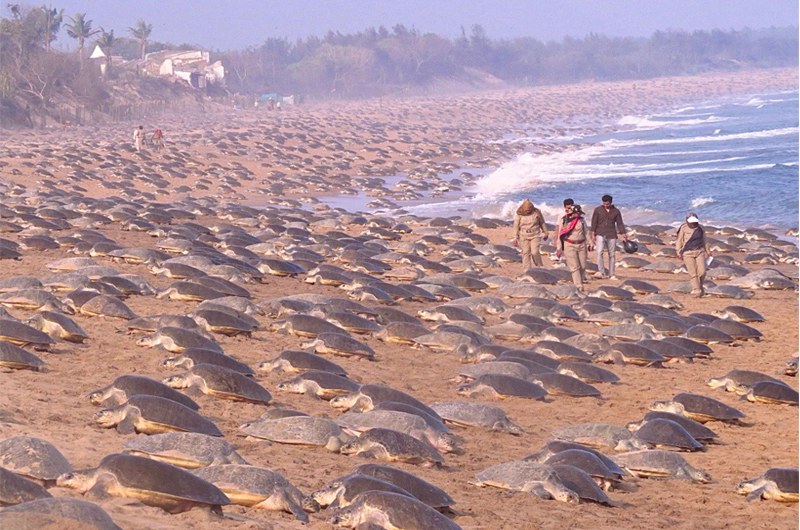Dedicated monitoring at nesting sites and other measures show that, despite the dangers posed by fishing fleets, poaching and climatic change, the sea turtle population off the Indian coasts is looking healthy, says Rina Mukherji, basing her article on a new report from Dakshin Foundation. Given the findings of the study, the researchers see collaboration among fishers, researchers and policymakers as the ideal arrangement that can lead to more sustainable conservation, benefiting both marine biodiversity and human well-being, she says
A new report from Dakshin Foundation, Monitoring Sea Turtles in India – 2008-2024, compiled along with the Indian Institute of Science, Bangalore, and the State Forest Departments of Odisha and the Andaman & Nicobar Islands, signals a heartening recovery of the sea turtle population. The report is the culmination of a 16-year-long research project from 2008 to 2024.
Sea turtles are a long-living, late-maturing and highly migratory species. Any changes in their populations occur over years or decades, making long-term monitoring essential for understanding population trends and environmental impacts. Rushikulya and Gahirmatha on the Odisha coast are important nesting sites for Olive Ridley sea turtles and were hence used for monitoring the population.
Olive Ridley turtles forage in pelagic waters but migrate to near-shore waters during the breeding season. Male and female Olive Ridley turtles migrate to Rushikulya around November, with males arriving before females. Mating happens in the near-shore waters, and males return to their foraging grounds afterwards. Female Olive Ridley turtles, on the other hand, remain in the near-shore waters until they complete nesting. The arribada or mass nesting of Olive Ridley turtles usually occurs once, or, rarely, twice each nesting season at both Gahirmatha and Rushikulya.
At Rushikulya, which is the largest nesting site of sea turtles, monitoring indicated a steady or growing population from 25,000-50,000 nests a season in the early 2000s to over 150,000 in the past decade, with over 400,000 nesting turtles estimated in some years. Since 2004, mass nesting has been happening nearly every year. In 2018, two mass nesting events occurred just two months apart. However, hatchling sex ratios are getting skewed toward females due to rising sand temperatures brought on by climate change, which raises questions about the population’s long-term viability.
Historically, the east coast population of Olive Ridley turtles has experienced significant decline due to direct harvesting of both eggs and adults. Industrialisation exacerbated the declines, as mechanised fishing led to large-scale mortality of Olive Ridleys. Over the past two decades, the population has shown signs of recovery, attributed to a combination of conservation measures and the resilience of the population. Yet, the population continues to face threats from fishing, coastal development and climate change. Besides, the breeding season of Olive Ridley turtles on the east coast coincides with the peak fishing season, which has led to large-scale mortality due to incidental capture, particularly in trawlers and in gill nets. Hence, the researchers feel it is crucial to monitor the population on land and at sea to ensure their continued recovery and long-term survival.

turtles, growing to over 6 feet in length, and weighing over 500 kg. They have the widest distribution among all sea turtles and are found in both
tropical and temperate waters in the Atlantic, Pacific and Indian Oceans.
To this end, a collaboration among fishers, researchers and policymakers could lead to more sustainable conservation, benefiting both marine biodiversity and human well-being. The Dakshin Foundation has simultaneously been monitoring the nesting of leatherback turtles in the Andaman & Nicobar Islands since 2008. The Leatherback Turtle, which nests in these islands, is the largest of the sea turtles, growing to over 6 feet in length, and weighing over 500 kg. The Leatherback feeds solely on jellyfish. These turtles are known for their leathery carapace, and (unlike other sea turtles) lack bony shells. They have the widest distribution among all sea turtles and are found in both tropical and temperate waters in the Atlantic, Pacific and Indian Oceans.
The nest monitoring programme of the Foundation conducted in the South and West Bay beaches of Little Andaman Island, showed a steady increase in Leatherback Turtle nesting in the region. Telemetry studies conducted from 2011 to 2014 reveal that these turtles from Little Andaman travel across the Indian Ocean during their migration, with some going as far east as Western Australia, and others as far west as Mozambique and Madagascar.
Over 150 turtles were fitted with passive integrated transponder tags as well as flipper tags in the past 15 years as part of the study. In the Nicobar Islands, surveys conducted in 2016 and 2019 showed that, after the 2004 Indian Ocean earthquake and tsunami, all important nesting beaches re-formed and continue to support nesting. The beaches of Great and Little Nicobar Islands continue to exhibit the highest nesting in the region, with over 1000 nests per season. The population appears to be stable, with some inter-annual variation, and it continues to be the most significant population of nesting leatherbacks in the northern Indian Ocean.
Given the findings of this study, the researchers see collaboration among fishers, researchers and policymakers as the ideal arrangement that can lead to more sustainable conservation, benefiting both marine biodiversity and human well-being.
(The writer is a senior award-winning journalist. She has worked for national newspapers and magazines in Mumbai and Kolkata, covering business, politics, public health, films, the arts and the environment. She is now primarily focused on climate change, human rights, food security and public health. She lives in Pune.)



 from Webdoux
from Webdoux